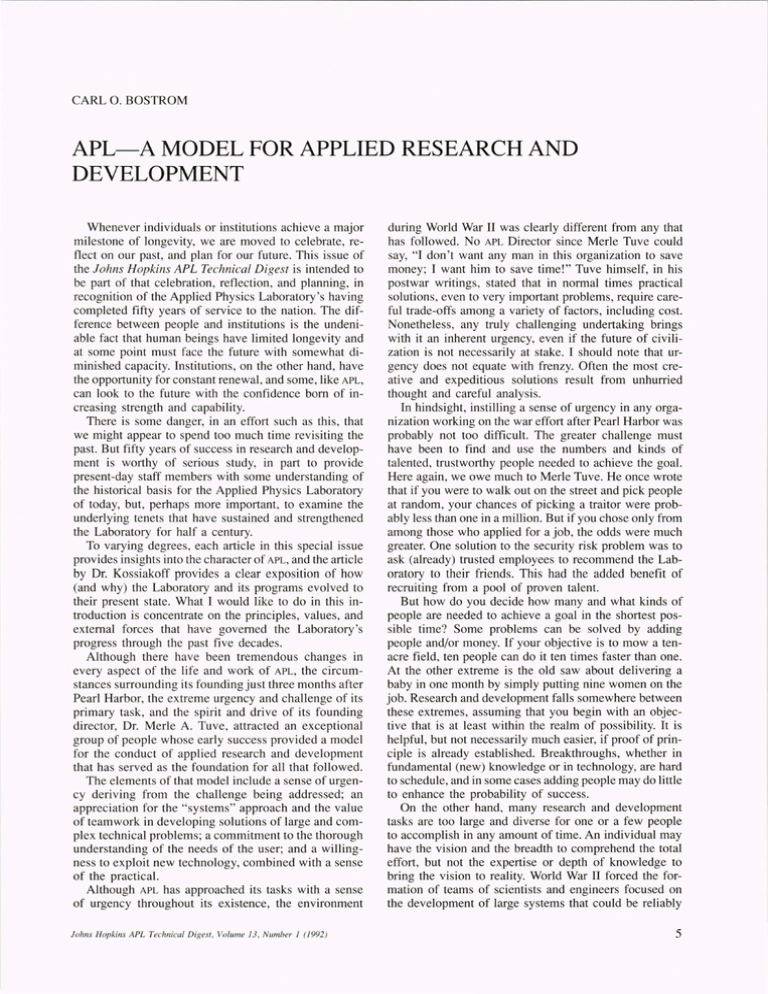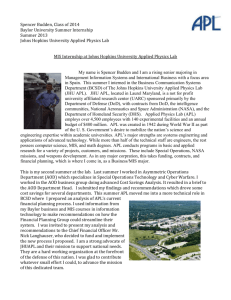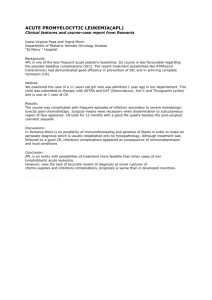APL-A MODEL FOR APPLIED RESEARCH AND DEVELOPMENT
advertisement

CARL O. BOSTROM APL-A MODEL FOR APPLIED RESEARCH AND DEVELOPMENT Whenever individuals or institutions achieve a major milestone of longevity, we are moved to celebrate, reflect on our past, and plan for our future. This issue of the fohns Hopkins APL Technical Digest is intended to be part of that celebration, reflection, and planning, in recognition of the Applied Physics Laboratory 's having completed fifty years of service to the nation. The difference between people and institutions is the undeniable fact that human beings have limited longevity and at some point must face the future with somewhat diminished capacity. Institutions, on the other hand, have the opportunity for constant renewal , and some, like APL, can look to the future with the confidence born of increasing strength and capability. There is some danger, in an effort such as this, that we might appear to spend too much time revisiting the past. But fifty years of success in research and development is worthy of serious study, in part to provide present-day staff members with some understanding of the historical basis for the Applied Physics Laboratory of today, but, perhaps more important, to examine the underlying tenets that have sustained and strengthened the Laboratory for half a century. To varying degrees, each article in this special issue provides insights into the character of APL, and the article by Dr. Kossiakoff provides a clear exposition of how (and why) the Laboratory and its programs evolved to their present state. What I would like to do in this introduction is concentrate on the principles, values, and external forces that have governed the Laboratory 's progress through the past five decades. Although there have been tremendous changes in every aspect of the life and work of APL, the circumstances surrounding its founding just three months after Pearl Harbor, the extreme urgency and challenge of its primary task, and the spirit and drive of its founding director, Dr. Merle A. Tuve, attracted an exceptional group of people whose early success provided a model for the conduct of applied research and development that has served as the foundation for all that followed. The elements of that model include a sense of urgency deriving from the challenge being addressed; an appreciation for the "systems" approach and the value of teamwork in developing solutions of large and complex technical problems; a commitment to the thorough understanding of the needs of the user; and a willingness to exploit new technology, combined with a sense of the practical. Although APL has approached its tasks with a sense of urgency throughout its existence, the environment f ohns Hopkins APL Technical Digest, Vo lume 13, Number J (1 992) during World War II was clearly different from any that has followed. No APL Director since Merle Tuve could say, "I don't want any man in this organization to save money; I want him to save time!" Tuve himself, in his postwar writings, stated that in normal times practical solutions, even to very important problems, require careful trade-offs among a variety of factors, including cost. Nonetheless, any truly challenging undertaking brings with it an inherent urgency, even if the future of civilization is not necessarily at stake. I should note that urgency does not equate with frenzy. Often the most creative and expeditious solutions result from unhurried thought and careful analysis. In hindsight, instilling a sense of urgency in any organization working on the war effort after Pearl Harbor was probably not too difficult. The greater challenge must have been to find and use the numbers and kinds of talented, trustworthy people needed to achieve the goal. Here again, we owe much to Merle Tuve. He once wrote that if you were to walk out on the street and pick people at random, your chances of picking a traitor were probably less than one in a million. But if you chose only from among those who applied for a job, the odds were much greater. One solution to the security risk problem was to ask (already) trusted employees to recommend the Laboratory to their friends. This had the added benefit of recruiting from a pool of proven talent. But how do you decide how many and what kinds of people are needed to achieve a goal in the shortest possible time? Some problems can be solved by adding people and/or money. If your objective is to mow a tenacre field, ten people can do it ten times faster than one. At the other extreme is the old saw about delivering a baby in one month by simply putting nine women on the job. Research and development falls somewhere between these extremes, assuming that you begin with an objective that is at least within the realm of possibility. It is helpful, but not necessarily much easier, if proof of principle is already established. Breakthroughs, whether in fundamental (new) knowledge or in technology, are hard to schedule, and in some cases adding people may do little to enhance the probability of success. On the other hand, many research and development tasks are too large and diverse for one or a few people to accomplish in any amount of time. An individual may have the vision and the breadth to comprehend the total effort, but not the expertise or depth of knowledge to bring the vision to reality. World War II forced the formation of teams of scientists and engineers focused on the development of large systems that could be reliably 5 c. O. Bostrom produced in quantity. The most notable of these team efforts were engaged in developing radar, the atomic bomb, and the proximity fuze. For the proximity fuze, the team concept was not only applied in the research and development phase, but also included industrial partners with responsibility for production. In large measure, the problem-solving techniques and approaches developed in the early years of APL account for the effectiveness of the Laboratory throughout its history. By definition, research and development are inefficient. That has to be true in any endeavor in which both the path to be followed and the ultimate outcome are uncertain. Often it is prudent to pursue two or more paths in parallel, and the best is not always the most practical. What works beautifully in the laboratory under the tender loving care of the inventor may be a disaster aboard ship or in a satellite. It is never enough to know that a technique or device works in principle, in isolation, or under ideal conditions. The real-world environment of operators, other system elements, background, noise, and the natural perversity of inanimate objects (which are some of the major elements of Murphy's Law) will inevitably frustrate the effort. For military systems, you also have to take into account your adversary's efforts to counter or defeat your best-laid plans. This brings me to other APL hallmarks, also part of the Tuve legacy, namely, to pay close attention to the users of our developments and technologies, to listen carefully, to take real data, to design critical experiments and realistic test programs, to live with the operators, to anticipate countermeasures and new threats, and to stay with a program throughout its operational life. Such total immersion is essential to gain the level of understanding necessary to apply real systems engineering. There is something of a myth in the (military) world of R&D that new capabilities evolve in a logical progression from basic research (6.1) through the RDT&E chain (6.2, 6.3, 6.4) and into production. Although this sometimes happens (technology push) and can result in dramatic new capability (e.g., the applications of nuclear fission), it is still true that necessity is the mother of invention. More often than not, innovation is needs-driven. A missile has to fly higher, faster, farther, tum sharper, and be more accurate. We need to communicate more information in a shorter time with higher fidelity. We need to devise more sensitive methods of detecting an adversary and find ways to reduce the detectability of our own systems. This "requirements pull" forces us to stay abreast of a broad array of technologies, and sometimes sets in motion new basic research or at least helps set priorities. For these reasons, APL activities range from basic research to test and evaluation and participation in fleet exercises. APL has a history of successful transfer of technology and system designs to industry for production. Examples include the VT fuze and gun director in the 1940s; Terrier, Tartar, and Talos missiles in the 1950s; the Transit navigation satellite and ground systems in the 1960s; the SYS-\ automatic detection and tracking system, basic elements of the Aegis combat system, and the Nova satellites in the 1970s; the New Threat Upgrade system, 6 important elements of the Battle Group Anti-Air Warfare Coordination program, and the Ground-Launched Cruise Missile Evaluation programs in the 1980s; and satellite radar altimetry, National AeroSpace Plane technology, and the Cooperative Engagement Capability in the 1990s. The Laboratory enjoys the support of many industrial contractors in part because of its record in spawning new systems and in part because of its willingness to continue technical involvement throughout the development, production, and deployment phases. In many programs, APL is highly valued as a source of independent, objective, and competent technical advice, assessment, and evaluation. Without growth (expansion), profit, or quantity production as motivating factors, APL (along with a very few similar organizations) represents a unique resource. Its objectivity, technical integrity, and its responsible independence have made the Laboratory a major asset to the United States Government. The Johns Hopkins University, because of its commitment to the mission of APL, has provided an environment that enables the Laboratory to attract and retain a highly competent and dedicated technical staff. Interactions with the other divisions of Hopkins and with other universities in education and research programs keep the APL staff current in areas of science, engineering, and technology relevant to our mission. The part-time graduate engineering program conducted by the G.W.c. Whiting School of Engineering is one of the largest in the country, and its success depends heavily on the faculty and leadership provided by the APL staff. Most of the 2000-plus students enrolled are employed by the government and its contractors in the Baltimore-Washington area. The number of separately funded tasks at APL has grown over the years from a few (or a few tens) in the 1960s to 300 or more today. That growth, however, does not represent expansion of staff or even so much diversification into totally new fields. Rather, it reflects the evolution of government management and contracting policy that has tended to divide programs into ever smaller entities for accounting purposes. ApL has steadfastly maintained its policy of not competing with industry, and it does not accept contracts from industry or collaborate with industry on proposing work to government sponsors. But the Laboratory works closely with industrial contractors in programs where APL has been assigned technical responsibilities. This policy has served the Laboratory and the Navy well for some fifty years by averting the possibility of institutional conflict of interest. Because of its strict adherence to these practices, APL has often been given access to relevant proprietary data by both government and industry and has earned a reputation for carefully protecting such information. It is important to remember that APL has never had any guaranteed (line item) funding from the government. We have always considered this situation to be proper and healthy, in that we must continually demonstrate to our sponsors the value of our efforts and the wisdom of their continuing to assign research programs to APL. By virtue of the Laboratory's long-term commitments in several areas, we bring to bear not only innovation and new Johns Hopkins APL Technical Digest, Vo lume 13, Number J (1992) APL-A Modelfor Applied Research and Development technology, but the experience and "corporate memory" so essential to systems engineering and development. As we look at external forces that have influenced the fortunes and progress of the Laboratory, there is a strong tendency to focus on the most recent events, the collapse of the Warsaw Pact and the rapid dissolution of the Soviet Union- truly momentous changes, the ramifications of which are not any more predictable than were the events themselves. But if we think back over the past fifty years, there have been many events that affected APL in direct and significant ways. The division of Central Europe and the realignment of power that followed World War II led quickly to the longterm confrontation between the Communist and Western powers. Many technologies that were under development during the war years came to fruition soon after, and profoundly affected the course of history for some forty years. Examples include jet aircraft and both guided and ballistic missiles. The development of nuclear weapons and long-range missile delivery systems by both sides produced a standoff which, many argue, kept Central Europe, the Soviet Union, and North America free of war from the late 1940s to the present day. Other parts of the world, however, were not so fortunate. In much of Asia, the Middle East, and parts of Africa and Latin America, revolutionary or expansionist wars were fueled by political or religious differences, and the opposing factions were usually aligned with and supported by the two superpower alliances. Most conflicts involved surrogates, but several, notably Korea, Vietnam, and Afghanistan, involved direct and large-scale use of U.S. or Soviet military forces. In place of direct military conflict, the continuous advance of technology and the accompanying growth in miEtary capability provided an alternative arena for competition between the two systems. The launch of Sputnik in 1957 started the space race, which continued through the Apollo years but peaked in the mid-1960s. The public support (and funding) for research and development in the United States is cyclic and often impelled by world events. In addition to the space race (and missile gap) peak, other increases in support occurred during the Korean war, after the energy crisis in the early seventies, and with the emergence of serious economic competition from Japan in the late seventies. As a result of the R&D of the seventies and eighties, and the military buildup during the eighties, the United States was able to prevail with almost astonishing ease in the 1991 war with Iraq. In general, the high technology employed in U.S. systems not only provided superior weapons, but was effective in reducing casualties. That level of performance is likely to become the norm for public acceptance of any future involvement of U.S. forces in regional conflicts. Tracing the history of the Laboratory's business environment and its relationship with sponsors and contracting agencies over the years could well be the subject of a separate long (and boring) article. Suffice it to say that the Laboratory's management has faced a great many Johns Hopkins APL Technical Digest , Volum e J3, Number I (1992 ) nontechnical challenges. Most have resulted from government efforts to eliminate wrongdoing, limit risk, or encourage desirable behavior. The objectives are generally laudable, but the solutions sometimes miss the mark and the implementation is usually cumbersome. The Laboratory's sustained high level of technical performance and productivity, despite the growing administrative burden, gives me confidence that our contributions to the nation will continue unabated into the future. Despite the dramatic geopolitical changes of the past few years, the need for a strong U.S. military capability remains, and there may be new opportunities for APL to contribute to the future economic well-being of the United States. The Laboratory has the creative technical staff, the modem facilities, the experienced leadership, and the tradition of excellence in public service to carry it forward with confidence into the twenty-first century. THE AUTHOR CARL O. BOSTROM, trained in nuclear physics, has spent his scientific career in space physics. Since 1980 he has been Director of The Johns Hopkins University Applied Physics Laboratory. An experimental physicist, Dr. Bostrom has designed a variety of scientific instruments for the study of energetic particles in the space environment. These instruments have been included on twenty-seven Navy and NASA spacecraft. Dr. Bostrom served as Project Scientist for four Navy research satellites associated with the development of the Transit navigation system. He has been Principal Investigator for several NASA-sponsored experiments. Born in Port Jefferson, N.Y., he obtained a B.S. in physics from Franklin and Marshall College in 1956, and M.S. (1958) and Ph.D. (1962) degrees in physics from Yale University. He joined APL in 1960 and led the space physics program from 1964 to 1974. Dr. Bostrom was appointed Chief Scientist of the Space Department in 1974 and Associate Department Head in 1978, and in 1979 held concurrent positions as Head of the Space Department and Deputy Director of the Laboratory. 7



